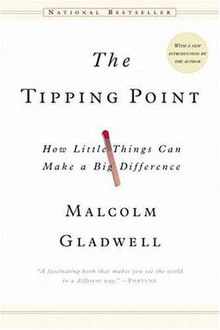The Tipping Point: How Little Things Make a Big Difference

Paperback edition
|
|
| Author | Malcolm Gladwell |
|---|---|
| Country | United States |
| Language | English |
| Subject | Psychology, sociology |
| Genre | Non-fiction |
| Publisher | Little Brown |
|
Publication date
|
2000 |
| Media type | Print (paperback) |
| Pages | 304 |
| ISBN |
(first edition) |
| OCLC | 55586972 |
| 302 22 | |
| LC Class | HM1033 .G53 2002 |
| Followed by | Blink |
The Tipping Point: How Little Things Can Make a Big Difference is the debut book by Malcolm Gladwell, first published by Little Brown in 2000. Gladwell defines a tipping point as "the moment of critical mass, the threshold, the boiling point". The book seeks to explain and describe the "mysterious" sociological changes that mark everyday life. As Gladwell states: "Ideas and products and messages and behaviors spread like viruses do". The examples of such changes in his book include the rise in popularity and sales of Hush Puppies shoes in the mid-1990s and the steep drop in New York City's crime rate after 1990.
Gladwell describes the "three rules of epidemics" (or the three "agents of change") in the tipping points of epidemics.
"The Law of the Few" is, as Gladwell states: "The success of any kind of social epidemic is heavily dependent on the involvement of people with a particular and rare set of social gifts". According to Gladwell, economists call this the "80/20 Principle, which is the idea that in any situation roughly 80 percent of the 'work' will be done by 20 percent of the participants" (see Pareto Principle). These people are described in the following ways:
The specific content of a message that renders its impact memorable. Popular children's television programs such as Sesame Street and Blue's Clues pioneered the properties of the stickiness factor, thus enhancing effective retention of educational content as well as entertainment value.
Human behavior is sensitive to and strongly influenced by its environment. Gladwell explains: "Epidemics are sensitive to the conditions and circumstances of the times and places in which they occur". For example, "zero tolerance" efforts to combat minor crimes such as fare-beating and vandalism and the New York subway led to a decline in more violent crimes city-wide. Gladwell describes the bystander effect, and explains how Dunbar's number plays into the tipping point, using Rebecca Wells' novel Divine Secrets of the Ya-Ya Sisterhood, evangelist John Wesley, and the high-tech firm W. L. Gore and Associates. Dunbar's number is the maximum number of individuals in a society or group that someone can have real social relationships with, which Gladwell dubs the "rule of 150."
...
Wikipedia
